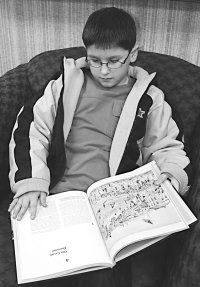| Derek Wells, a student at Pinnacle Canyon Academy took second place in the state in the geography competition for fourth to eighth grade students this past month. Last year he took first place. The local charter school is now four years old and just went through an extensive evaluation process by Utah State University. |
Based on the six purposes of charter schools set forth by the Utah Legislature under code 53A-Ia-503 when they created the ability for charter schools to exist under the umbrella of the public school system, a study done by Utah State University’s Center for the School of the Future shows that the Pinnacle Canyon Academy in Carbonville gets high marks on all levels.
The school, which opened in 1999 and was one of the original charter institutions to open in that first year, began operations with much controversy and speculation.
When the school began operation, they were housed in extra rooms at the Greenwell Motel. The next year they moved to what had previously been a private religious school building near the Carbon County Country Club, the place where they reside today.
However, things have changed alot since that first year, with enrollment going up tremendously and the new facility changing every year since the move, mostly getting larger and by experience getting better.
“We have grown and matured in many ways,” says Roberta Hardy, the schools administrator. “As of right now we have 264 regular school students and 40 preschoolers.”
The school, which exists within the boundaries of Carbon School District, but is not affiliated with it, has the largest percentage of public school students enrolled in it compared to the districts size, of any charter school in the state. Within that enrollment is also includes 10 students from the Emery County School District.
When the school opened many in the community saw the school as an “elite” place, where only gifted and rich peoples kids went to school.
If that was ever totally true is in dispute, but what is not in dispute is that the school is very well rounded in terms of it’s student makeup today.
According to Hardy, over 40 percent of the students are on free or reduced lunch programs. That compares to the school district, which according to Sharon Patten, director of food service for the district, over 50 percent of the students are on free and reduced rates.
“That 40 percent shows that we are not just getting rich families kids here,” says Hardy.
Another area in which Pinnacle Canyon has grown is in the number of special education students they have in their school.
“We have a fairly high rate of special education students,” notes the administrator. “We have grown in that area from 11 percent of our student body to 28 percent.”
While almost everything else has grown, the complaint from many in the public arena has been that the charter schools in Utah have had little accountability in terms of meeting their goals and if they are making a difference in the children who are enrolled in their schools.
One of the problems with this is that there is little history, in terms of general numbers for comparison, and in some ways it is even hard to compare charter institutions between themselves. That is because some schools have aimed their enrollment at socially and economically challenged groups, while others have started schools that emphasize technical skills or the arts.
To compare students from these various backgrounds is difficult. In addition students came into these schools performing at different levels based on their prior education and experience.
The growth of individual schools, with Pinnacle Canyon being one of the leaders percentage wise, is also a factor. More students means more elements to select from, but also dilutes the pool as well. Students who entered one of the schools four years ago, may have a very different profile than those entering today.
Therefore, the study concentrated on what the legislature decided would be the discerning measures of performance as pointed out in the code. These included the following areas.
• Continue to improve student learning.
• Encourage the use of different and innovative teaching methods.
• Create new professional opportunities for educators that will allow them to actively participate in designing and implementing the learning program at the school.
• Increase choice of learning opportunities for students.
• Establish new models of public schools and a new form of accountability for schools that emphasizes the measurement of learning outcomes and the creation of innovative measurement tools.
• Provide opportunities for greater parental involvement in management decisions at the school level.
The report used five levels of evaluation for each of these areas: exemplary contribution, substantial contribution, partial contribution, no contribution and one level where the examiners felt there wasn’t enough data to do the evaluation, which was called incomplete data.
In the six categories, Pinnacle Canyon Academy did not have one rating below substantial contribution and in fact led the state in two of the six with a exemplary contribution in continuing to improve student learning and providing opportunities for greater parental involvement in management decisions at the school level.
Altogether, the eight original charter schools were evaluated and the only other school that had two top ratings was the Center City Charter School that is located in the Salt Lake City School District. The other four newer schools were not included in the study.
In addition the study also looked at various other aspects of the schools including characteristics of various groups within charter schools, charter school testing results compared to local districts and other miscellaneous subjects.

